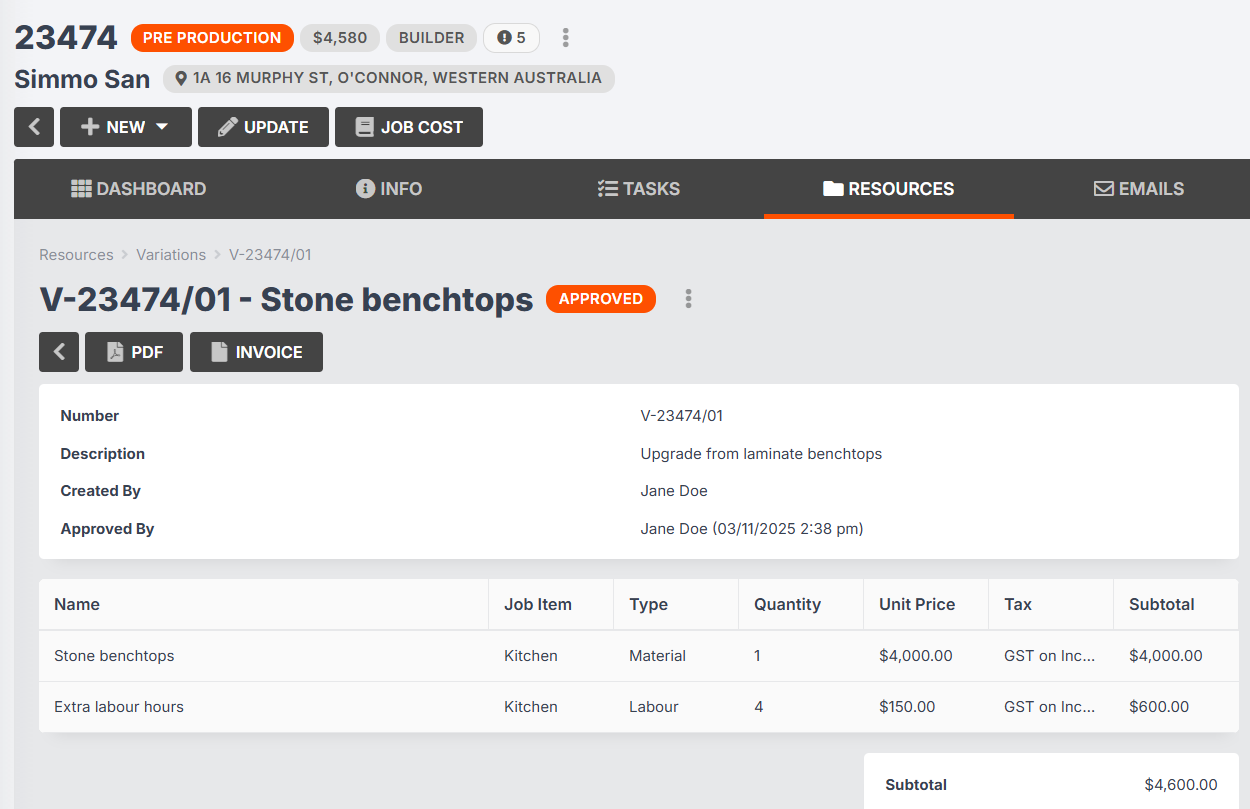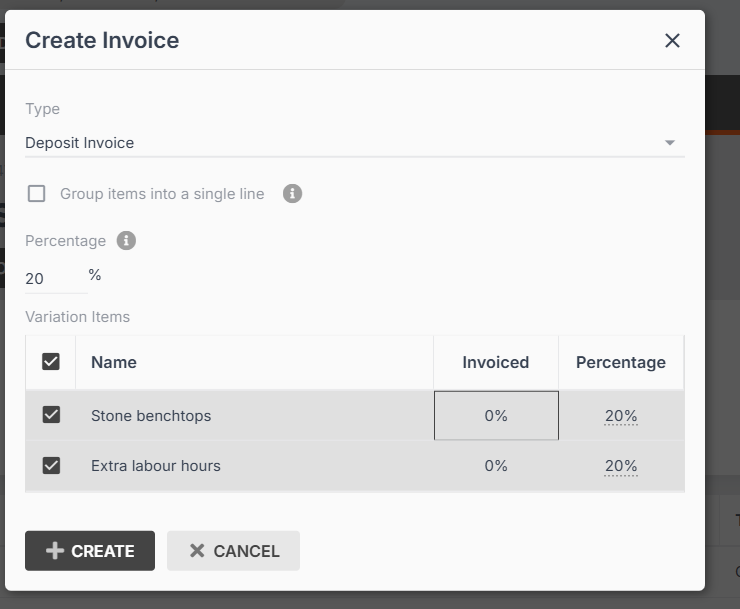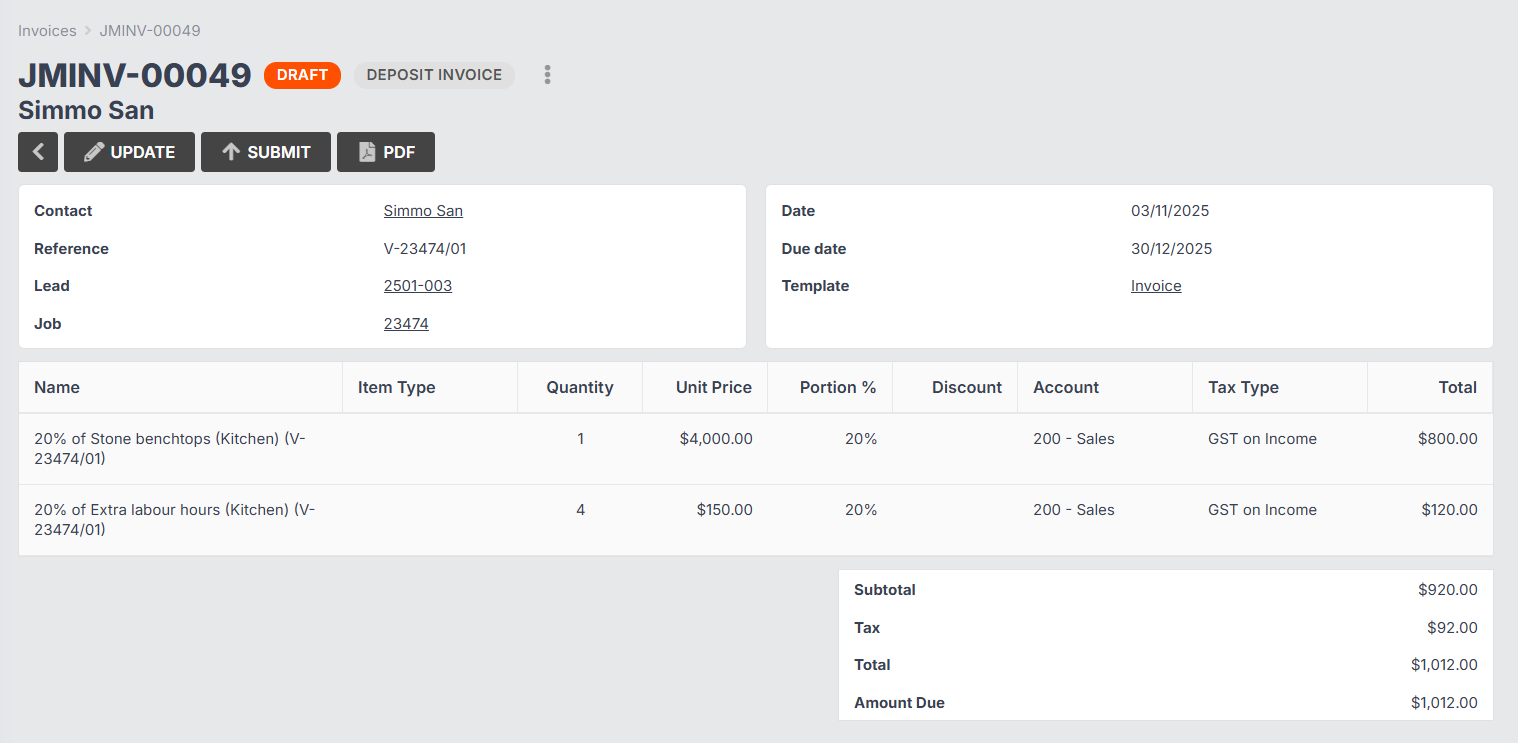How to Create an Invoice from a Lead, Quote, Job, or Job Variation
Easily generate invoices in Jobman straight from your lead, quote, job, or job variation. Edit as needed, then sync to your accounting software for approval!
Please Note: Jobman cannot create credit notes (e.g. negative invoices). This must be handled directly within your accounting software.
In this article:
Creating an Invoice from a Lead
Creating an Invoice from a Quote
Creating an Invoice from a Job
Creating an Invoice from a Job Variation
Creating an Invoice from a Lead
Create an invoice from a lead with an accepted quote by following these steps:
- From your lead, click New > Invoice.

- You will be taken to a blank invoice. Click Add New > Quote.

- Choose your accepted quote from the drop-down and click Create.
- Choose your Invoice Type, e.g. Deposit Invoice, Full Invoice, etc.
Select Group items into a single line if you want to roll all quote items into one line per tax type.
Example: All items with the tax type GST on Income will show in one line & all items with BAS Excluded will show in another line.
- Select the quote items you want to invoice.
- If you've selected partial or deposit invoice, you can enter the percentage you would like to invoice, which can be changed for each quote item.
Enter the percentage or deposit amount you would like to charge under Percentage - this will apply to all selected Quote Items as shown below:

- Finally, click Create.
You will be taken to the newly created invoice. Its status will be Draft.
Creating an Invoice from a Quote
Create an invoice from an accepted quote by following these steps:
Note: The quote must be updated to a status that can be invoiced, e.g. Quote Accepted.
Read more: Quote Statuses
How to Access Accepted Quotes
From the User Menu Panel on the left, navigate to Quotes.
Then use the filter or search function to find the quote you want (see below).

Click into the quote you want, and up the top you'll see options to Revise, Email, Print PDF, or Invoice.

- Click Invoice.
- Choose your Invoice Type, e.g. Deposit Invoice, Full Invoice, etc.
Select Group items into a single line if you want to roll all quote items into one line per tax type.
Example: All items with the tax type GST on Income will show in one line & all items with BAS Excluded will show in another line.
- Select the quote items you want to invoice.
- If you've selected partial or deposit invoice, you can enter the percentage you would like to invoice, which can be changed for each quote item.
Enter the percentage or deposit amount you would like to charge under Percentage - this will apply to all selected Quote Items as shown below:

- Finally, click Create.
You will be taken to the newly created invoice. Its status will be Draft.
Creating an Invoice from a Job
Create an invoice from a job by following these steps:
From your job, click New > Invoice:

- Select an invoice type, enter a reference if needed, and click Create.
- You will be taken to a blank invoice, where you can add a quote and quote items as above, or manually add individual line items and amounts.
- Click Save Changes.
Creating an Invoice from a Job Variation
To create an invoice from a job variation, follow these steps:
Inside your job, go to Resources > Variations and click into the variation you want to invoice.

Note: The job variation must be in approved status.
Click Invoice:

Select an invoice type, enter a percentage if needed, or set custom percentages for individual variation lines, then click Create:

You will be taken to your draft invoice. You can either press Submit to send directly to your accounting software, or press Update to edit further:

- When updating in invoice, you can click on any line to edit the name, item type, quantity, unit price, portion (percentage), discount, account, or tax type.
You can also click Add New to add a new line item, invoice subtraction, quote, or job variation:

When you are finished, Save Changes:

IMPORTANT: if you have generated your invoice from a job variation with negative value, you will not be able to save or submit your invoice until you have updated the invoice in such a way as to make the total value positive - for example, by adding a quote to the invoice (with positive value greater than the negative value.
Need to update your invoice?
Check the details of your invoice - for example, the due date. If any changes are required, simply click Update, make your edits, and Save Changes.
Tip: Set default percentages for your invoices by going to Settings > Accounting > Invoice Types.
Invoice Percentage Warnings:

Invoice Numbers are automatically generated by Jobman. Once the invoice syncs with your accounting software, it will be automatically overridden with the accounting software's invoice number.
We recommend that you wait for your accounting software to sync before emailing or printing your invoice, so that the client is not issued an invoice with the incorrect number.
Please Note: You must click the Submit button on an invoice for it to sync with your accounting software. You cannot sync an invoice by manually changing the status, e.g. to Submitted or Awaiting Payment.
If you need to update an invoice, its status must first be changed back to Draft.
To change the status of an invoice, simply click on its current status at the top left:

Did you know? If your accounting software is connected to Jobman, any invoices paid by clients will automatically update to the Paid status in Jobman.







